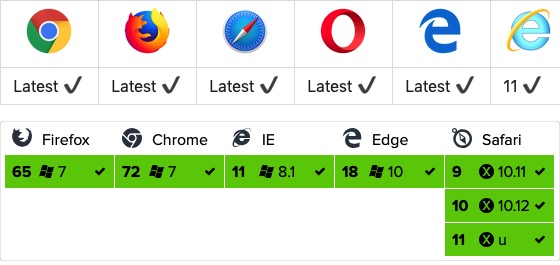Vue3 Ajax(axios)
Vue 版本推荐使用 axios 来完成 ajax 请求。
Axios 是一个基于 Promise 的 HTTP 库,可以用在浏览器和 node.js 中。
Github开源地址: https://github.com/axios/axios
安装方法
使用 cdn:
<script src="https://unpkg.com/axios/dist/axios.min.js"></script>
或
<script src="https://cdn.staticfile.org/axios/0.18.0/axios.min.js"></script>
使用 npm:
$ npm install axios
使用 bower:
$ bower install axios
使用 yarn:
$ yarn add axios
使用方法:
Vue.axios.get(api).then((response) => { console.log(response.data) }) this.axios.get(api).then((response) => { console.log(response.data) }) this.$http.get(api).then((response) => { console.log(response.data) })
浏览器支持情况

GET 方法
我们可以简单的读取 JSON 数据:
GET 实例
尝试一下 »
使用 response.data 读取 JSON 数据:
GET 实例
尝试一下 »
GET 方法传递参数格式如下:
传递参数说明
POST 方法
POST 实例
尝试一下 »
POST 方法传递参数格式如下:
传递参数说明
执行多个并发请求
实例
axios API
可以通过向 axios 传递相关配置来创建请求。
实例
请求方法的别名
为方便使用,官方为所有支持的请求方法提供了别名,可以直接使用别名来发起请求:
axios.request(config) axios.get(url[, config]) axios.delete(url[, config]) axios.head(url[, config]) axios.post(url[, data[, config]]) axios.put(url[, data[, config]]) axios.patch(url[, data[, config]])
注意:在使用别名方法时, url、method、data 这些属性都不必在配置中指定。
并发
处理并发请求的助手函数:
axios.all(iterable) axios.spread(callback)
创建实例
可以使用自定义配置新建一个 axios 实例:
axios.create([config]) const instance = axios.create({ baseURL: 'https://some-domain.com/api/', timeout: 1000, headers: {'X-Custom-Header': 'foobar'} });
实例方法
以下是可用的实例方法。指定的配置将与实例的配置合并:
axios#request(config) axios#get(url[, config]) axios#delete(url[, config]) axios#head(url[, config]) axios#post(url[, data[, config]]) axios#put(url[, data[, config]]) axios#patch(url[, data[, config]])
请求配置项
下面是创建请求时可用的配置选项,注意只有 url 是必需的。如果没有指定 method,请求将默认使用 get 方法。
{ // `url` 是用于请求的服务器 URL url: "/user", // `method` 是创建请求时使用的方法 method: "get", // 默认是 get // `baseURL` 将自动加在 `url` 前面,除非 `url` 是一个绝对 URL。 // 它可以通过设置一个 `baseURL` 便于为 axios 实例的方法传递相对 URL baseURL: "https://some-domain.com/api/", // `transformRequest` 允许在向服务器发送前,修改请求数据 // 只能用在 "PUT", "POST" 和 "PATCH" 这几个请求方法 // 后面数组中的函数必须返回一个字符串,或 ArrayBuffer,或 Stream transformRequest: [function (data) { // 对 data 进行任意转换处理 return data; }], // `transformResponse` 在传递给 then/catch 前,允许修改响应数据 transformResponse: [function (data) { // 对 data 进行任意转换处理 return data; }], // `headers` 是即将被发送的自定义请求头 headers: {"X-Requested-With": "XMLHttpRequest"}, // `params` 是即将与请求一起发送的 URL 参数 // 必须是一个无格式对象(plain object)或 URLSearchParams 对象 params: { ID: 12345 }, // `paramsSerializer` 是一个负责 `params` 序列化的函数 // (e.g. https://www.npmjs.com/package/qs, http://api.jquery.com/jquery.param/) paramsSerializer: function(params) { return Qs.stringify(params, {arrayFormat: "brackets"}) }, // `data` 是作为请求主体被发送的数据 // 只适用于这些请求方法 "PUT", "POST", 和 "PATCH" // 在没有设置 `transformRequest` 时,必须是以下类型之一: // - string, plain object, ArrayBuffer, ArrayBufferView, URLSearchParams // - 浏览器专属:FormData, File, Blob // - Node 专属: Stream data: { firstName: "Fred" }, // `timeout` 指定请求超时的毫秒数(0 表示无超时时间) // 如果请求花费了超过 `timeout` 的时间,请求将被中断 timeout: 1000, // `withCredentials` 表示跨域请求时是否需要使用凭证 withCredentials: false, // 默认的 // `adapter` 允许自定义处理请求,以使测试更轻松 // 返回一个 promise 并应用一个有效的响应 (查阅 [response docs](#response-api)). adapter: function (config) { /* ... */ }, // `auth` 表示应该使用 HTTP 基础验证,并提供凭据 // 这将设置一个 `Authorization` 头,覆写掉现有的任意使用 `headers` 设置的自定义 `Authorization`头 auth: { username: "janedoe", password: "s00pers3cret" }, // `responseType` 表示服务器响应的数据类型,可以是 "arraybuffer", "blob", "document", "json", "text", "stream" responseType: "json", // 默认的 // `xsrfCookieName` 是用作 xsrf token 的值的cookie的名称 xsrfCookieName: "XSRF-TOKEN", // default // `xsrfHeaderName` 是承载 xsrf token 的值的 HTTP 头的名称 xsrfHeaderName: "X-XSRF-TOKEN", // 默认的 // `onUploadProgress` 允许为上传处理进度事件 onUploadProgress: function (progressEvent) { // 对原生进度事件的处理 }, // `onDownloadProgress` 允许为下载处理进度事件 onDownloadProgress: function (progressEvent) { // 对原生进度事件的处理 }, // `maxContentLength` 定义允许的响应内容的最大尺寸 maxContentLength: 2000, // `validateStatus` 定义对于给定的HTTP 响应状态码是 resolve 或 reject promise 。如果 `validateStatus` 返回 `true` (或者设置为 `null` 或 `undefined`),promise 将被 resolve; 否则,promise 将被 rejecte validateStatus: function (status) { return status >= 200 && status < 300; // 默认的 }, // `maxRedirects` 定义在 node.js 中 follow 的最大重定向数目 // 如果设置为0,将不会 follow 任何重定向 maxRedirects: 5, // 默认的 // `httpAgent` 和 `httpsAgent` 分别在 node.js 中用于定义在执行 http 和 https 时使用的自定义代理。允许像这样配置选项: // `keepAlive` 默认没有启用 httpAgent: new http.Agent({ keepAlive: true }), httpsAgent: new https.Agent({ keepAlive: true }), // "proxy" 定义代理服务器的主机名称和端口 // `auth` 表示 HTTP 基础验证应当用于连接代理,并提供凭据 // 这将会设置一个 `Proxy-Authorization` 头,覆写掉已有的通过使用 `header` 设置的自定义 `Proxy-Authorization` 头。 proxy: { host: "127.0.0.1", port: 9000, auth: : { username: "mikeymike", password: "rapunz3l" } }, // `cancelToken` 指定用于取消请求的 cancel token // (查看后面的 Cancellation 这节了解更多) cancelToken: new CancelToken(function (cancel) { }) }
响应结构
axios请求的响应包含以下信息:
{ // `data` 由服务器提供的响应 data: {}, // `status` HTTP 状态码 status: 200, // `statusText` 来自服务器响应的 HTTP 状态信息 statusText: "OK", // `headers` 服务器响应的头 headers: {}, // `config` 是为请求提供的配置信息 config: {} }
使用 then 时,会接收下面这样的响应:
axios.get("/user/12345") .then(function(response) { console.log(response.data); console.log(response.status); console.log(response.statusText); console.log(response.headers); console.log(response.config); });
在使用 catch 时,或传递 rejection callback 作为 then 的第二个参数时,响应可以通过 error 对象可被使用。
配置的默认值
你可以指定将被用在各个请求的配置默认值。
全局的 axios 默认值:
axios.defaults.baseURL = 'https://api.example.com'; axios.defaults.headers.common['Authorization'] = AUTH_TOKEN; axios.defaults.headers.post['Content-Type'] = 'application/x-www-form-urlencoded';
自定义实例默认值:
// 创建实例时设置配置的默认值 var instance = axios.create({ baseURL: 'https://api.example.com' }); // 在实例已创建后修改默认值 instance.defaults.headers.common['Authorization'] = AUTH_TOKEN;
配置的优先顺序
配置会以一个优先顺序进行合并。这个顺序是:在 lib/defaults.js 找到的库的默认值,然后是实例的 defaults 属性,最后是请求的 config 参数。后者将优先于前者。这里是一个例子:
// 使用由库提供的配置的默认值来创建实例 // 此时超时配置的默认值是 `0` var instance = axios.create(); // 覆写库的超时默认值 // 现在,在超时前,所有请求都会等待 2.5 秒 instance.defaults.timeout = 2500; // 为已知需要花费很长时间的请求覆写超时设置 instance.get('/longRequest', { timeout: 5000 });
拦截器
在请求或响应被 then 或 catch 处理前拦截它们。
// 添加请求拦截器 axios.interceptors.request.use(function (config) { // 在发送请求之前做些什么 return config; }, function (error) { // 对请求错误做些什么 return Promise.reject(error); }); // 添加响应拦截器 axios.interceptors.response.use(function (response) { // 对响应数据做点什么 return response; }, function (error) { // 对响应错误做点什么 return Promise.reject(error); });
如果你想在稍后移除拦截器,可以这样:
var myInterceptor = axios.interceptors.request.use(function () {/*...*/}); axios.interceptors.request.eject(myInterceptor);
可以为自定义 axios 实例添加拦截器。
var instance = axios.create(); instance.interceptors.request.use(function () {/*...*/});
错误处理:
axios.get('/user/12345') .catch(function (error) { if (error.response) { // 请求已发出,但服务器响应的状态码不在 2xx 范围内 console.log(error.response.data); console.log(error.response.status); console.log(error.response.headers); } else { // Something happened in setting up the request that triggered an Error console.log('Error', error.message); } console.log(error.config); });
可以使用 validateStatus 配置选项定义一个自定义 HTTP 状态码的错误范围。
axios.get('/user/12345', { validateStatus: function (status) { return status < 500; // 状态码在大于或等于500时才会 reject } })
取消
使用 cancel token 取消请求。
Axios 的 cancel token API 基于cancelable promises proposal
可以使用 CancelToken.source 工厂方法创建 cancel token,像这样:
var CancelToken = axios.CancelToken; var source = CancelToken.source(); axios.get('/user/12345', { cancelToken: source.token }).catch(function(thrown) { if (axios.isCancel(thrown)) { console.log('Request canceled', thrown.message); } else { // 处理错误 } }); // 取消请求(message 参数是可选的) source.cancel('Operation canceled by the user.');
还可以通过传递一个 executor 函数到 CancelToken 的构造函数来创建 cancel token:
var CancelToken = axios.CancelToken; var cancel; axios.get('/user/12345', { cancelToken: new CancelToken(function executor(c) { // executor 函数接收一个 cancel 函数作为参数 cancel = c; }) }); // 取消请求 cancel();
注意:可以使用同一个 cancel token 取消多个请求。
请求时使用 application/x-www-form-urlencoded
axios 会默认序列化 JavaScript 对象为 JSON。 如果想使用 application/x-www-form-urlencoded 格式,你可以使用下面的配置。
浏览器
在浏览器环境,你可以使用 URLSearchParams API:
const params = new URLSearchParams(); params.append('param1', 'value1'); params.append('param2', 'value2'); axios.post('/foo', params);
URLSearchParams 不是所有的浏览器均支持。
除此之外,你可以使用 qs 库来编码数据:
const qs = require('qs'); axios.post('/foo', qs.stringify({ 'bar': 123 })); // Or in another way (ES6), import qs from 'qs'; const data = { 'bar': 123 }; const options = { method: 'POST', headers: { 'content-type': 'application/x-www-form-urlencoded' }, data: qs.stringify(data), url, }; axios(options);
Node.js 环境
在 node.js里, 可以使用 querystring 模块:
const querystring = require('querystring'); axios.post('http://something.com/', querystring.stringify({ foo: 'bar' }));
当然,同浏览器一样,你还可以使用 qs 库。
Promises
axios 依赖原生的 ES6 Promise 实现而被支持。
如果你的环境不支持 ES6 Promise,你可以使用 polyfill。
TypeScript支持
axios 包含 TypeScript 的定义。
import axios from "axios"; axios.get("/user?ID=12345");